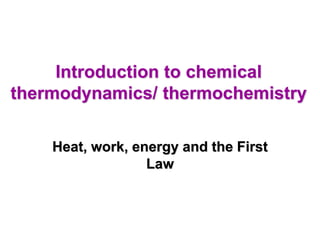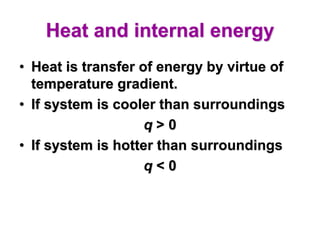Thermochemistry is the study of heat and energy changes in chemical and physical processes. It is concerned with energy changes that accompany physical and chemical processes at constant volume or constant pressure.
The first law of thermochemistry states that the quality of heat evolved or absorbed during a chemical reaction is the same, regardless of the pathway between the initial and final states. Hess's law states that the total enthalpy change for a reaction is the sum of the enthalpy changes for the individual steps of the reaction.
Enthalpy change (ΔH) of a reaction is the heat absorbed or released when one mole of the reaction occurs at constant pressure. It can be measured using a bomb calorimeter. Common standard






















![Examples
i. Calculate the standard heat of reduction of ferric oxide by aluminum which
proceeds according to the following reaction:
2Al(s) + Fe2O3(s) 2Fe(s) +Al2O3(s) ΔH = x kJmol-1
Given that the standard heat of formation of Fe2O3 and Al2O3 are -820.06kJmol-1
and -1669.83kJmol-1 respectively.
= (0 – 1669.83) – (0 – 820.06) = - 849.77kJmol-1
ii. Calculate the heat of the following reaction given that the heat of formation of
H2O(l), CO(g), and CO2(g) are -285.77, -108.78 and -393.30kJmol-1 respectively
at 20oC.
CO(g) + H2O(l) CO2(g) + H2(g)
= [(0 + (-393.30)) – (-108.78 + (-285.77))] = 1.25kJmol-1
Measurement of Heat of Reaction
This is usually measured accurately using the calorimeter. A calorimeter
containing the aqueous solution is often used to measure the heat absorbed or
released by a chemical reaction.
Thus; Q = MCΔT
Where, M = mass of water or solution; C = specific heat capacity of water or
solution, ΔT = Tempt rise
The specific heat capacity of water is 4.2jkg-1k-1.
Specific heat capacity = Heat capacity / mass](https://image.slidesharecdn.com/che101thermochem-231005120706-81d853f4/85/CHE-101-Thermochem-ppt-23-320.jpg)


![Example 1: Given that the heat of formation of water and gaseous
carbon(iv)oxide are -285kJmol-1 and -393kJmol-1 respectively and the
heat of combustion of gaseous butane is -2874kJmol-1. Calculate the
standard enthalpy of formation of gaseous butane.
C(s) + O2(g) CO2(g) ΔH = -393kJmol-1
H2(g) + 1/2O2(g) H2O(l) ΔH = -285kJmol-1
C4H10(g) + 13/2O2(g) 4CO2(g) + 5H2O(l) ΔH = -2874kJmol-1
-2874 = [(4 x -393) + (5 x -285)] – [hfC4H10 + (13/2 x 0)]
Hf(C4H10) = -123kJmol-1
Method 2: Using Hess’s law; ΔH1 = ΔH2 + ΔH3 + ΔH4 = (4 x -393) + (5 x -
285) + (+2874) = -123kJmol-1
Example 2: Find the enthalpy change for the reaction
C2H4(g) + H2(g) C2H6(g)
Given that the enthalpy of formation of C2H6 and C2H4 are -84.6kJmol-1
and 52.3kJmol-1 respectively.
Hreactant = -84.6 – [52.3 + 0] = -136.9kJmol-1
Method 2: Using Hess’s law; ΔH3 + ΔH1 = ΔH2
H3 = H2 – H1 = -846 – (+52.3) = -136.9kJmol-1](https://image.slidesharecdn.com/che101thermochem-231005120706-81d853f4/85/CHE-101-Thermochem-ppt-26-320.jpg)

![Spontaneity of Reaction
Three factors determine the spontaneity of reaction:
- Enthalpy;
- Entropy
- Free energy
i. Entropy: This is a measure of the degree of disorder or randomness of
a system. It is represented by letter S and a change in it by ΔSθ.
ΔSθ = ΔSθ
2 - ΔSθ
1
The SI unit of entropy is JK-1
Example: Nitrogen gas reacts with hydrogen gas to form ammonia gas.
Given that the standard entropies of nitrogen, hydrogen and ammonia
gases are: 192, 131, and 193Jk-1mol-1 respectively. Calculate the
standard state entropy change for the reaction.
N2(g) + 3H2(g) 2NH3(g) ΔSθ = ?
= [2(193) – (192 + 393)] = - 199JK-1mol-1
Since the standard entropy change is negative, there is a decrease in
randomness or disorder of the system.](https://image.slidesharecdn.com/che101thermochem-231005120706-81d853f4/85/CHE-101-Thermochem-ppt-28-320.jpg)

